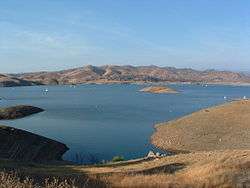Millerton Lake
Millerton Lake is an artificial lake near the town of Friant about 15 mi (24 km) north of downtown Fresno. The reservoir was created by the construction of 319 ft (97 m) high Friant Dam on the San Joaquin River which, with the lake, serves as much of the county line between Fresno County to the south and Madera County to the north.
| Millerton Lake | |
|---|---|
 | |
| Location | Sierra Nevada Fresno- / Madera-Counties, California |
| Coordinates | 37.0425°N 119.6545°W |
| Type | Reservoir |
| Primary inflows | San Joaquin River |
| Primary outflows | Friant-Kern Canal Madera Canal San Joaquin River |
| Catchment area | 1,675 sq mi (4,340 km2) |
| Basin countries | United States |
| Surface area | 4,900 acres (2,000 ha) |
| Max. depth | 319 ft (97 m) |
| Water volume | 520,528 acre⋅ft (0.642062 km3) |
| Surface elevation | 561 ft (171 m) |
| References | U.S. Geological Survey Geographic Names Information System: Millerton Lake |
Part of the Central Valley Project, the dam was built by the United States Bureau of Reclamation (USBR) and was completed in 1942. The lake stores water for irrigation, which is distributed by the Madera and Friant-Kern Canals to the San Joaquin Valley. It has an instantaneous capacity of 520,528 acre⋅ft (0.642062 km3).
Secondary uses include flood control and recreation, including swimming, fishing, water skiing and camping. A 25 MW hydroelectric plant operated by the Friant Power Authority produces electricity from large releases and two smaller plants use water released for a fish hatchery and to maintain minimum-flow in the river.
Prior to the construction of Friant Dam, the current lake bed was the site of the town of Millerton, the first county seat of Fresno County.
The California Office of Environmental Health Hazard Assessment has issued a safe eating advisory for fish caught in the Millerton Lake due to elevated levels of mercury.[1]
Environmental impacts
By diverting most of the San Joaquin River for irrigation, the Friant Dam has caused about 60 miles (97 km) of the river to run dry except in high water years when floodwaters are spilled from the dam. The desiccation of the river has caused the degradation of large stretches of riverside habitat and marshes, and has nearly eliminated the historic chinook salmon run that once reached about 15,000 fish each year. Reduction in flows has also increased the concentration of pesticide and fertilizer runoff in the river contributing to pollution that has further impacted aquatic species.[2]
On September 13, 2006, after eighteen years of litigation, environmental groups, fisherman and the USBR reached an agreement on releasing part of the water currently diverted into the irrigation canals into the San Joaquin River in order to help restore the river and its native fish and wildlife. The first water was released on October 2, 2009 at a rate of 185 cubic feet per second (5.2 m3/s).[3] By 2014, these "restoration flows" will be increased to 302,000 acre feet (373,000 dam3) per year, or 417 cubic feet per second (11.8 m3/s), on top of the 117,000 acre feet (144,000 dam3) that is currently released for agricultural purposes. However, the river restoration project will cause a 12–20% reduction in irrigation water delivered from Friant Dam.[4]
See also
- List of dams and reservoirs in California
- List of lakes in California
- List of largest reservoirs of California
- Temperance Flat Dam Proposed extension of Millerton Lake.
References
- OEHHA, Admin (2019-04-16). "Millerton Lake". oehha.ca.gov. Retrieved 2019-04-23.
- "Restoring the San Joaquin River: Following an 18-year legal battle, a great California river once given up for dead is on the verge of a comeback". Natural Resources Defense Council. Retrieved 2012-04-05.
- Sheehan, Tim (2009-10-02). "Friant Dam releases water to begin river rebirth". The Fresno Bee.
- "Restoration Flows" (PDF). Friant Water Authority. Archived from the original (PDF) on 2012-04-07. Retrieved 2012-04-05.
- Department of Water Resources (2011). "Station Meta Data: Friant Dam (Millerton) (MIL)". California Data Exchange Center. State of California. Retrieved 24 August 2011.
- Central Valley Project Friant Division (4 June 2009). "Friant Dam". U.S. Bureau of Reclamation. Retrieved 24 August 2011.
- Central Valley Project Friant Division (21 April 2011). "Friant Division Project". U.S. Bureau of Reclamation. Retrieved 24 August 2011.